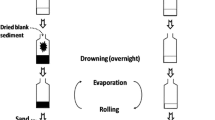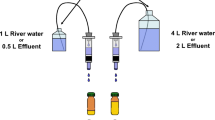Abstract
Effect-directed analysis (EDA)-based strategies have been increasingly used in order to identify the causative link between adverse (eco-)toxic effects and chemical contaminants. In this study, we report the development and use of an EDA approach to identify endocrine-disrupting chemicals (EDCs) in a multi-contaminated river sediment. The battery of in vitro reporter cell-based bioassays, measuring estrogenic, (anti)androgenic, dioxin-like, and pregnane X receptor (PXR)-like activities, revealed multi-contamination profiles. To isolate active compounds of a wide polarity range, we established a multi-step fractionation procedure combining: (1) a primary fractionation step using normal phase-based solid-phase extraction (SPE), validated with a mixture of 12 non-polar to polar standard EDCs; (2) a secondary fractionation using reversed-phase-based high-performance liquid chromatography (RP-HPLC) calibrated with 33 standard EDCs; and (3) a purification step using a recombinant estrogen receptor (ER) affinity column. In vitro SPE and HPLC profiles revealed that ER and PXR activities were mainly due to polar to mid-polar compounds, while dioxin-like and anti-androgenic activities were in the less polar fractions. The overall procedure allowed final isolation and identification of new environmental PXR (e.g., di-iso-octylphthalate) and ER (e.g., 2,4-di-tert-butylphenol and 2,6-di-tert-butyl-α-methoxy-p-cresol) ligands by using gas chromatography coupled with mass spectrometry with full-scan mode acquisition in mid-polar fractions. In vitro biological activity of these chemicals was further confirmed using commercial standards, with di-iso-octylphthalate identified for the first time as a potent hPXR environmental agonist.










Similar content being viewed by others
References
Sumpter JP (2005) Endocrine disrupters in the aquatic environment: an overview. Acta Hydrochim Hydrobiol 33:9–16
Devier MH, Mazellier P, Ait-Aissa S, Budzinski H (2011) New challenges in environmental analytical chemistry: identification of toxic compounds in complex mixtures. C R Chim 14:766–779
Brack W (2003) Effect-directed analysis: a promising tool for the identification of organic toxicants in complex mixtures? Anal Bioanal Chem 377:397–407
Hill EM, Evans KL, Horwood J, Rostkowski P, Oladapo FO, Gibson R, Shears JA, Tyler CR (2010) Profiles and some initial identification of (anti)androgenic compounds in fish exposed to wastewater treatment works effluents. Environ Sci Technol 44:1137–1143
Thomas KV, Hurst MR, Matthiessen P, Waldock MJ (2001) Characterization of estrogenic compounds in water samples collected from United Kingdom estuaries. Environ Toxicol Chem 20:2165–2170
Houtman CJ, Booij P, Jover E, del Rio DP, Swart K, van Velzen M, Vreuls R, Legler J, Brouwer A, Lamoree MH (2006) Estrogenic and dioxin-like compounds in sediment from Zierikzee harbour identified with CALUX assay-directed fractionation combined with one and two dimensional gas chromatography analyses. Chemosphere 65:2244–2252
Luebcke-von Varel U, Machala M, Ciganek M, Neca J, Pencikova K, Palkova L, Vondracek J, Loeffler I, Streck G, Reifferscheid G, Flueckiger-Isler S, Weiss JM, Lamoree M, Brack W (2011) Polar compounds dominate in vitro effects of sediment extracts. Environ Sci Technol 45:2384–2390
Schmitt C, Streck G, Lamoree M, Leonards P, Brack W, de Deckere E (2010) Effect directed analysis of riverine sediments—the usefulness of Potamopyrgus antipodarum for in vivo effect confirmation of endocrine disruption. Aquat Toxicol 101:237–243
Houtman CJ, Cenijn PH, Hamers T, Lamoree MH, Legler J, Murk AJ, Brouwer A (2004) Toxicological profiling of sediments using in vitro bioassays, with emphasis on endocrine disruption. Environ Toxicol Chem 23:32–40
Weiss JM, Hamers T, Thomas KV, van der Linden S, Leonards PEG, Lamoree MH (2009) Masking effect of anti-androgens on androgenic activity in European river sediment unveiled by effect-directed analysis. Anal Bioanal Chem 394:1385–1397
Brack W, Schirmer K (2003) Effect-directed identification of oxygen and sulfur heterocycles as major polycyclic aromatic cytochrome P4501A–inducers in a contaminated sediment. Environ Sci Technol 37:3062–3070
Creusot N, Kinani S, Balaguer P, Tapie N, LeMenach K, Maillot-Marechal E, Porcher JM, Budzinski H, Ait-Aissa S (2010) Evaluation of an hPXR reporter gene assay for the detection of aquatic emerging pollutants: screening of chemicals and application to water samples. Anal Bioanal Chem 396:569–583
Kinani S, Bouchonnet S, Creusot N, Bourcier S, Balaguer P, Porcher JM, Ait-Aissa S (2010) Bioanalytical characterisation of multiple endocrine- and dioxin-like activities in sediments from reference and impacted small rivers. Environ Pollut 158:74–83
Mnif W, Dagnino S, Escande A, Pillon A, Fenet H, Gomez E, Casellas C, Duchesne MJ, Hernandez-Raquet G, Cavailles V, Balaguer P, Bartegi A (2010) Biological analysis of endocrine-disrupting compounds in Tunisian sewage treatment plants. Arch Environ Cont Toxicol 59:1–12
Kretschmer XC, Baldwin WS (2005) CAR and PXR: xenosensors of endocrine disrupters? Chem-Biol Interact 155:111–128
Lemaire G, Mnif W, Pascussi JM, Pillon A, Rabenoelina F, Fenet H, Gomez E, Casellas C, Nicolas JC, Cavailles V, Duchesne MJ, Balaguer P (2006) Identification of new human pregnane X receptor ligands among pesticides using a stable reporter cell system. Toxicol Sci 91:501–509
Mnif W, Pascussi JM, Pillon A, Escande A, Bartegi A, Nicolas JC, Cavailles V, Duchesne MJ, Balaguer P (2007) Estrogens and antiestrogens activate hPXR. Toxicol Lett 170:19–29
Orans J, Teotico DG, Redinbo MR (2005) The nuclear xenobiotic receptor pregnane X receptor: recent insights and new challenges. Mol Endocrinol 19:2891–2900
Sanchez W, Ait-Aissa S, Palluel O, Ditche J-M, Porcher J-M (2007) Preliminary investigation of multi-biomarker responses in three-spined stickleback (Gasterosteus aculeatus L.) sampled in contaminated streams. Ecotoxicology 16:279–287
Pillon A, Boussioux AM, Escande A, Ait-Aissa S, Gomez E, Fenet H, Ruff M, Moras D, Vignon F, Duchesne MJ, Casellas C, Nicolas JC, Balaguer P (2005) Binding of estrogenic compounds to recombinant estrogen receptor-α: application to environmental analysis. Environ Health Persp 113:278–284
Creusot N (2011) Contribution de l’approche effect directed analysis à l’identification de perturbateurs endocriniens dans les milieux aquatiques. Thesis University of Bordeaux I, Bordeaux, p 288
Cailleaud K, Forget-Leray J, Souissi S, Hilde D, LeMenach K, Budzinski H (2007) Seasonal variations of hydrophobic organic contaminant concentrations in the water-column of the Seine Estuary and their transfer to a planktonic species Eurytemora affinis (Calanoida, copepoda). Part 1: PCBs and PAHs. Chemosphere 70:270–280
Balaguer P, Francois F, Comunale F, Fenet H, Boussioux AM, Pons M, Nicolas JC, Casellas C (1999) Reporter cell lines to study the estrogenic effects of xenoestrogens. Sci Tot Environ 233:47–56
Wilson VS, Bobseine K, Lambright CR, Gray LE (2002) A novel cell line, MDA-kb2, that stably expresses an androgen- and glucocorticoid-responsive reporter for the detection of hormone receptor agonists and antagonists. Toxicol Sci 66:69–81
Louiz I, Kinani S, Gouze ME, Ben-Attia M, Menif D, Bouchonnet S, Porcher JM, Ben-Hassine OK, Ait-Aissa S (2008) Monitoring of dioxin-like, estrogenic and anti-androgenic activities in sediments of the bizerta lagoon (Tunisia) by means of in vitro cell-based bioassays: contribution of low concentrations of polynuclear aromatic hydrocarbons (PAHs). Sci Tot Environ 402:318–329
Aït-Aïssa S, Laskowski S, Laville N, Porcher JM, Brion F (2010) Anti-androgenic activities of environmental pesticides in the MDA-kb2 reporter cell line. Toxicol in Vitro 24:1979–1985
Kojima H, Takeuchi S, Nagai T (2010) Endocrine-disrupting potential of pesticides via nuclear receptors and aryl hydrocarbon receptor. J Health Sci 56:374–386
Koh CH, Khim JS, Villeneuve DL, Kannan K, Johnson BG, Giesy JP (2005) Instrumental and bioanalytical measures of dioxin-like and estrogenic compounds and activities associated with sediment from the Korean coast. Ecotoxicol Environ Saf 61:366–379
Song MY, Xu Y, Jiang QT, Lam PKS, O’Toole DK, Giesy JP, Jiang GB (2006) Measurement of estrogenic activity in sediments from Haihe and Dagu River, China. Environ Int 32:676–681
Brack W, Schirmer K, Erdinger L, Hollert H (2005) Effect-directed analysis of mutagens and ethoxyresorufin-O-deethylase inducers in aquatic sediments. Environ Toxicol Chem 24:2445–2458
Milnes MR, Garcia A, Grossman E, Grun F, Shiotsugu J, Tabb MM, Kawashima Y, Katsu Y, Watanabe H, Iguchi T, Blumberg B (2008) Activation of steroid and xenobiotic receptor (SXR, NR1I2) and its orthologs in laboratory, toxicologic, and genome model species. Environ Health Persp 116:880–885
Schymanski EL, Bataineh M, Goss KU, Brack W (2009) Integrated analytical and computer tools for structure elucidation in effect-directed analysis. Trends Anal Chem 28:550–561
Krauss M, Singer H, Hollender J (2010) LC-high resolution MS in environmental analysis: from target screening to the identification of unknowns. Anal Bioanal Chem 397:943–951
Petrovic M, Barceló D (2007) LC-MS for identifying photodegradation products of pharmaceuticals in the environment. Trends Anal Chem 26:486–493
Riu A, Balaguer P, Perdu E, Pandelova M, Piccinelli R, Gustafsson JA, Leclercq C, Schramm KW, Dagnino S, Debrauwer L, Cravedi JP, Zalko D (2008) Characterisation of bioactive compounds in infant formulas using immobilised recombinant estrogen receptor-[alpha] affinity columns. Food Cheml Toxicol 46:3268–3278
Tollefsen K-E, Nilsen J-A (2008) Binding of alkylphenols and alkylated non-phenolics to rainbow trout (Oncorhynchus mykiss) hepatic estrogen receptors. Ecotoxicol Environ Saf 69:163–172
Sun H, Xu X-L, Qu J-H, Hong X, Wang Y-B, Xu L-C, Wang X-R (2008) 4-alkylphenols and related chemicals show similar effect on the function of human and rat estrogen receptor [alpha] in reporter gene assay. Chemosphere 71:582–588
Nishihara T, Nishikawa J, Kanayama T, Dakeyama F, Saito K, Imagawa M, Takatori S, Kitagawa Y, Hori S, Utsumi H (2000) Estrogenic activities of 517 chemicals by yeast two-hybrid assay. J Health Sci 46:282–298
Wada H, Tarumi H, Imazato S, Narimatsu M, Ebisu S (2004) In vitro estrogenicity of resin composites. J Dent Res 83:222–226
Smital T, Terzic S, Zaja R, Senta I, Pivcevic B, Popovic M, Mikac I, Tollefsen KE, Thomas KV, Ahel M (2010) Assessment of toxicological profiles of the municipal wastewater effluents using chemical analyses and bioassays. Ecotoxicol Environ Saf 74:844–851
Dagnino S, Bellet V, Grimaldi M, Riu A, Aït-Aïssa S, Cavaillès V, Fenet H, Balaguer P (2012) Affinity purification using recombinant PXR as a tool to characterize environmental ligands. Environ Toxicol. doi:10.1002/tox.20787
Tapie N (2006) Contamination des écosystèmes aquatiques par les PCB et PBDE: application à l’estuaire de la Gironde. Thesis University of Bordeaux I, Bordeaux
Tapie N, Dévier MH, Soulier C, Creusot N, Le Menach K, Aït-Aïssa S, Vrana B, Budzinski H (2011) Passive samplers for chemical substance monitoring and associated toxicity assessment in water. Wat Sci Technol 63:2418–2426
Togola A, Budzinski H (2007) Analytical development for analysis of pharmaceuticals in water samples by SPE and GC-MS. Anal Bioanal Chem 388:627–635
Cailleaud K, Forget-Leray J, Souissi S, Lardy S, Augagneur S, Budzinski H (2007) Seasonal variation of hydrophobic organic contaminant concentrations in the water-column of the Seine Estuary and their transfer to a planktonic species Eurytemora affinis (Calanoid, copepod). Part 2: alkylphenol-polyethoxylates. Chemosphere 70:281–287
Acknowledgments
This study was supported by the French Ministry of Ecology (P190-ECOPI) and by a doctoral fellowship to NC (contract No. CIFRE703/2008). The authors wish to thank Dr. Marina Grimaldi for her help with the purification on the hERα column and two anonymous reviewers for helping to improve the quality of the manuscript.
Author information
Authors and Affiliations
Corresponding author
Electronic supplementary material
Below is the link to the electronic supplementary material.
ESM 1
(DOCX 74 kb)
Rights and permissions
About this article
Cite this article
Creusot, N., Budzinski, H., Balaguer, P. et al. Effect-directed analysis of endocrine-disrupting compounds in multi-contaminated sediment: identification of novel ligands of estrogen and pregnane X receptors. Anal Bioanal Chem 405, 2553–2566 (2013). https://doi.org/10.1007/s00216-013-6708-5
Received:
Revised:
Accepted:
Published:
Issue Date:
DOI: https://doi.org/10.1007/s00216-013-6708-5




